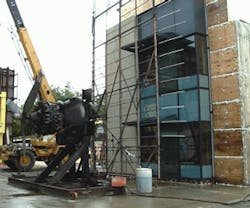Automated methods of monitoring the long-term performance of building envelopes have been few. However, inexpensive datalogging tools and sensors are offering more clues to conditions that are inaccessible to direct observation, helping facilities managers get immediate alerts about problems, pinpoint locations, and develop remedies. Combined with weather information, the building data provides a new level of detail into performance.
Although pre-construction mock-ups can test a model’s performance and allow designers to refine the details, the actual performance of a constructed building will inevitably vary from that of a partial mock-up, says Robert Kistler, manager with The Facade Group, a consulting firm based in Portland, OR. Nonetheless, mock-ups are useful for examining air and water infiltration, as well as structural and seismic performance.
For completed buildings, datalogging can be an effective tool for precise, long-term monitoring of actual conditions. In the case of a one-story office building in the Pacific Northwest, The Facade Group is using wireless moisture sensors embedded in the exterior walls and a datalogger to determine the impact from the lack of a specified vapor barrier that a contractor did not install before the walls were enclosed. The wall assembly includes plywood sheathing, which caused concerns about excessive moisture in the walls and the possibility of mold developing in the porous plywood.
The sensors and datalogger will monitor the building for a year, and the data will be correlated with weather information during that period. The results will help to determine the envelope’s performance through all seasons and weather conditions. Drawing conclusions from this information will help the building owner to evaluate the risk for future problems and determine the most cost-effective remedies. The cost for the instrumentation was roughly $600 for the datalogger and $150 per wireless sensor, for a total of $1,500.
Another approach to moisture testing is detection tape. To measure fluctuating moisture levels, Tacoma, WA-based Detec Systems installs a 1.5-inch-wide polyester tape with two copper conductors. The sensors are designed to provide continual monitoring for 20 to 30 years. On low-slope roofs, the tape is installed in grids, allowing for precise location of breaches within the squares of the grid. In external wall cavities the tape can be installed around the entire perimeter and under all doors, windows, and other penetrations.
Moisture-Resistance Data Resolves Disputes in Condos
In condominium buildings, the tape has been able to discriminate between envelope failures and other problems caused by the actions of individual condo owners. In one case, a condo owner sought replacement from the building owner of a wood floor damaged by water. While the log indicated high moisture levels on a rainy day, this was a one-time reading limited to one condo. Ultimately, it was determined that the moisture problem was caused by the condo owner leaving his deck’s sliding glass door open, eliminating suspicion about the integrity of the building’s deck construction.
According to Duncan Townsend, vice president of Detec Systems, the cost to install the moisture detection tape ranges from $600 to $1,300 per condo. Townsend also notes that buildings with a moisture detection system may have lower insurance premiums.
Correlating moisture levels with historical weather information can offer clues to the true cause of a problem. For example, if high moisture levels were detected on a day that was warm and sunny, the cause might be heat transfer and condensation rather than a water leak. Automated and continual monitoring can also alert building owners to a problem long before it is visible.
Another application for the moisture tape is vegetated roofs, where repairs for leaks can be particularly expensive due to the cost of disturbing and replacing the landscaping. With the tape installed on the top or “breach” side of the membrane, it can better locate the source of a leak, whereas sensors located under the membrane, on the “leak” side, as well as roof scans may detect the extent of the moist area, but not the location of the breach.
The Facade Group’s Kistler envisions that if dataloggers and sensors are installed in buildings as a routine practice in the future, the result will be a new level of integration and performance for building envelopes, mechanical systems, and electrical systems.
Chris Olson ([email protected]) is editor in chief of Buildings magazine.
